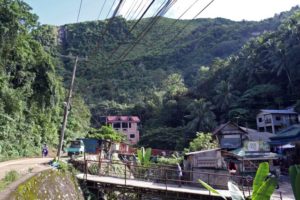
Because of the large cracks seen on the top left side of the mountain in Barangay Buhisan, Cebu City, village officials offer relocation sites for 30 households (300 residents) who are at risk.
BUHISAN SOIL CRACKS
It has been five years since the 7.2-magnitude earthquake rocked Cebu and Bohol, and Gervin Sanghanid, now 18, has felt no reason to fear that he would end up losing his home as a result of that quake.
Until now.
This time, Sanghanid could not even afford to have a peaceful sleep in their house situated on the banks of Kinalumsan river in Sitio Sandayong, Barangay Buhisan, Cebu City.
It seemed that the senior high school student and his family may have to flee the area since it was one of the danger zones identified by the Mines and Geosciences Bureau in Central Visayas (MGB-7) that is at risk, as it is prone to landslides with large cracks having appeared on his village’s slopes.
Nagiel Bañacia, chief of the Cebu City Disaster Risk Reduction and Management Office (CCDRRMO), said they may compel around 300 individuals from 30 families residing in Sitio Sandayong to relocate to safer places if state geologists will stick to their previous findings that the area still poses imminent threat to its residents.
CCDRRMO’s hazard team, which is composed of at least 10 members, conducted an assessment in Sitio Sandayong yesterday following the plea of Buhisan Barangay Captain Gremar Barete for updates on the cracks found on the mountain slopes in their village.
The cracks were actually the aftermath of the earthquake that struck Cebu and Bohol provinces in 2013.
The tremor also triggered a landslide which left visible scars, slightly covered by vegetation, on the slopes until now.
Sanghanid said they had thought that the worse, particularly after the aftershocks, stopped.
“Sukad niundang na ang mga aftershocks, wala na mi nakuyawan. Unya wala na man nilihok sad ang yuta (Since the aftershocks stopped, we were no longer scared. Then the soil has stopped moving),” he added.
Sanghanid said his family has to evacuate, adding they might have to end up in Lapu-Lapu City where his mother’s family owns a lot.
But it could not be said of the other residents who have nowhere to go.
This was the reason why they opted to stay even if government geologists have recommended their relocation since nearly a year ago.
Waiting for MGB-7 recommendations
In December 2017, MGB-7 issued a landslide threat advisory and recommended for an immediate evacuation of the 30 families whose houses are located right below the slopes and on the riverbank.
In the wake of last month’s massive landslide in Barangay Tinaan, Naga City that has left over 70 people dead, local authorities have become more aware of adopting preemptive measures.
“We are now coming up with the findings and recommendations, and will be submitted to MGB-7 who has the authority to declare if the area is still risky for residents,” said Bañacia.
However, he begged off from providing the initial results of their team’s assessment, which took them the entire day on Saturday (October 20), since everything is yet to be made official.
When asked if CCDRRMO may possibly and immediately conduct a forced evacuation if MGB-7 will still uphold their findings and recommendations made five years ago, Bañacia said yes.
“Before we can do any forced evacuation, we need the opinion from MGB-7 so that there will be a basis as to why we need to conduct one,” he, however, added.
Stop digging, cutting trees
CCDRRMO was supposed to conduct the assessment in Sitio Sandayong on Monday, October 22, since their team, on Friday, was deployed in Barangay Pulangbato to also inspect any threats following reports of the presence of illegal quarrying operators there.
“This is also an urgent matter so we decided to do it right away so that, hopefully, we can furnish the MGB of our findings as early as possible,” Bañacia said.
He added that they may submit their official findings to the state’s mining bureau next week.
In the meantime, Bañacia urged the residents not to conduct any activities on the mountains that may alter its state, such as simple digging and cutting down of trees.
Barangay Buhisan is one of the 19 mountainous villages in Cebu City that were identified as areas highly susceptible to landslides by MGB-7’s geohazard maps.
MGB-7, in a statement sent to reporters on Friday, said their bureau is willing to conduct a reassessment, and issue an updated recommendations for Sitio Sandayong.
Relocation
Barete tapped the help of MGB-7, through the Cebu City Environment and Natural Resources Office (CCENRO) and CCDRRMO, to give them updates on the cracks found in their village.
The landslide that struck in Naga City, which resulted to 78 deaths, prompted the village chief to revisit the advisory sent by the experts.
He earlier said that uncooperative residents failed them to fully comply with MGB-7’s recommendations in 2013.
Now, Barete said the barangay government is willing to provide a relocation site for the affected residents if it would persuade them to abandon the area, once the agency still finds it perilous.
“It’s in Sitio Talisayan, which is already distances away from where the cracks can be found. The barangay has negotiated with the owner who is willing for the residents to pay (for the land) through installment,” said Barete.
He also hoped that the CCDRRMO and MGB-7 will come up with the official findings and recommendations as soon as possible.
“Once they do, the barangay will be conducting a survey and profiling of all the affected residents. In this way, we can determine who will be prioritized for the relocation,” Barete said.
“Because it is possible that those within the danger zone have properties in safer places where they can transfer right away. We have to give priority to those who cannot afford to rebuild their houses,” he added.